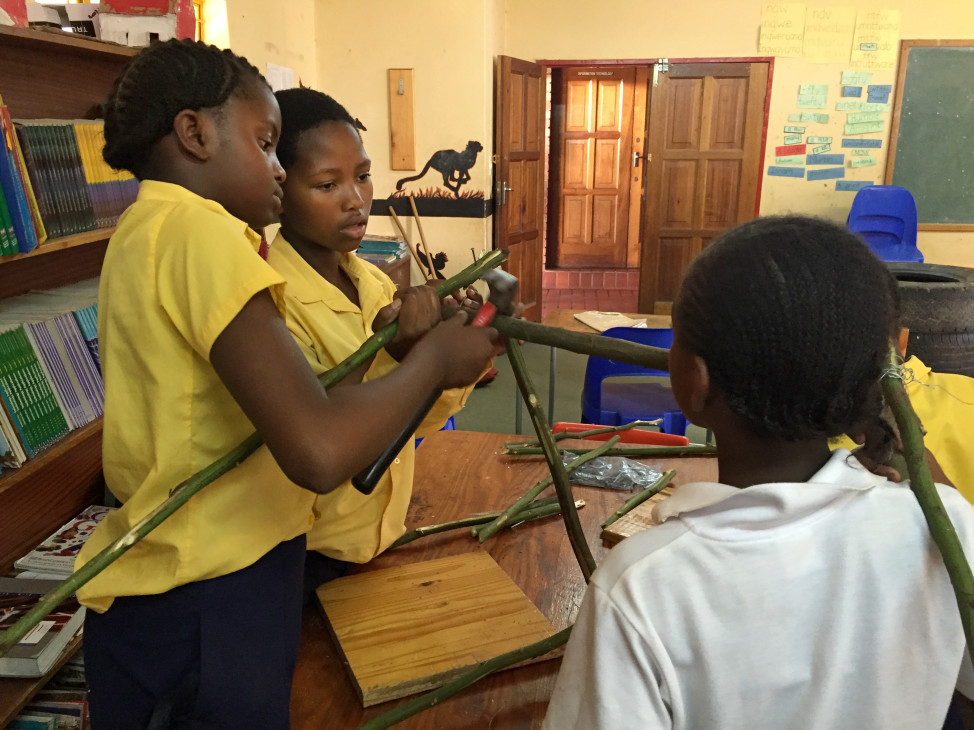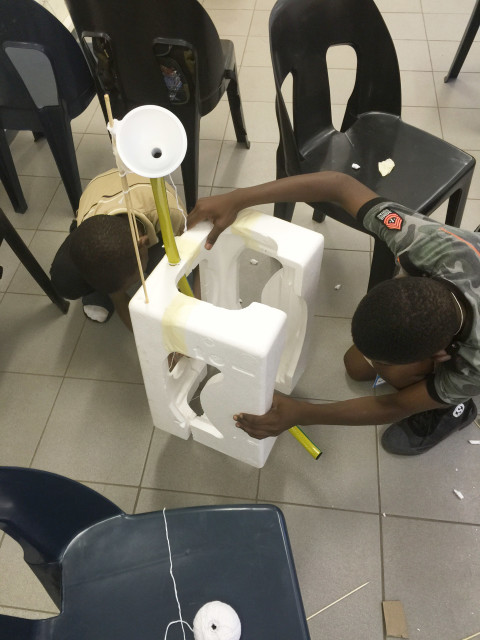
Girls in the ‘Design Squad Global Club’ at SOS Children’s Village school in Mbabane, Swaziland built a waste bin to reduce litter around their school. (WGBH Educational Foundation)
In an increasingly digitized world, cultivating a science, technology, engineering and math (STEM) mindset is crucial to mint a new generation of makers who understand unmet global needs. One partnership is looking to do that by building bridges between U.S. and southern African kids to give STEM skills a boost.
Using after-school programs or “clubs,” Design Squad Global (DSG), an online hub, matches U.S. kids 8-13-years-old with their counterparts in Swaziland, Botswana and South Africa to design engineering projects, collaborate, and gain an understanding of each other.
“We have eight sites in southern Africa and eight sites in the U.S. where … after-school programs have been matched up,” said DSG Executive Producer Marisa Wolsky in an interview.
The south African region, while recognizing the importance of early STEM education for economic growth and global competitiveness, has “a critical lack of curriculum time, teaching expertise and resources for STEM,” said DSG’s Southern African Facilitator Dylan Busa in an email.
DSG promotes “global competency” and gives kids “the engineering skills they need,” said Wolsky. But its priority is to expose children to the design process and teach them how to solve related problems. “There are many solutions to a problem rather than one right answer,” she said. “That’s another big thing we try to promote.”
The 10-week program is the result of a partnership between Boston’s public broadcaster WGBH, the Public Broadcasting Service (PBS) and the global development organization FHI360.
FHI360, which maintains a presence in 60 low-to-middle-income countries and helps to identify local needs and feasible solutions for DSG, is piloting programs to provide kids in southern Africa with more STEM opportunities.
Reality checks
Funded by the U.S. National Science Foundation (NSF), the initiative promotes teamwork and creative problem-solving. At the same time, children “gain new perspectives and the ability to communicate and collaborate with people with different cultures,” said Valentine Kass, Program Director at NSF’s Division of Research on Learning in Formal and Informal Settings.
The process of sharing solutions and exchanging feedback gives children a unique cross-cultural learning opportunity, where partner clubs often realize very quickly how different the needs are in other countries.

‘Design Squad Global’ kids at the Phatsimong Youth Center in Gaborone, Botswana build a mouse trap-inspired pill dispenser. The contraption is meant to help kids remember to take their pills in a country with a high prevalence of HIV/AIDS. (WGBH Educational Foundation)
Project designs often reflect those needs, with children from Botswana, for example, where there is a high prevalence of HIV/AIDS, creating “a daily medication toy” to remind kids to take their medicine.
Working with lower-income kids also returned some interesting findings about how little children in the United States and South Africa, for example, knew about each other’s cultures before they began collaborating through DSG.
“The South African kids thought the [U.S.] kids … would all be rich, they would all be really, really, really smart,” said Wolsky. “And they learned that, actually no, they have challenges in their community just as they do.”
Participating children in Sweto, South Africa, were surprised to learn that English was not the first language of the kids they were matched with in the U.S. And children in the United States, where crafting materials are readily available, also knew very little about the unmet needs of their African counterparts.
This is particularly true of southern Africa, said Busa, where there are “significant shortages in equipment” and trained teachers, both of which account for low enrollment in some STEM fields.
Mindful of shortages, DSG tries to ensure that the materials needed for the children’s projects are accessible and offers alternatives if they are not. “So for instance,’ said Wolsky, “when a group built their emergency shelters in the U.S., they used wooden planks and … plastic sheeting. And in … South Africa, they used bamboo rods.”
Design Squad Global is still in its pilot phase. But it is set to expand to other countries and build new partnerships in the fall. This is a crucial step in an increasingly interconnected world, said Wolsky, particularly for U.S. kids who might not know enough about the rest of the world, and for kids in developing regions facing challenges in STEM education.
For southern Africa, the biggest need in STEM education is for “clear and actionable policy,” said Busa. That means coming up with a well-articulated curricula that receive adequate instructional time, highly skilled STEM educators who can foster creativity, exploration, experimentation, and digital technology and internet bandwidth resources.
“If we are going to create engineers of the future,” added Wolsky, “the only way to do that is to get them to understand that we live in a global world and that whatever you design or build needs to have that global context in order for it to ultimately be useful.”

One response to “‘Design Squad Global’ Hooks Up US, Africa Kids in STEM Exchange”
[…] more about the exchange in the article ‘Design Squad Global’ Hooks Up US, Africa Kids in STEM Exchange and more about SOS Children’s Village schools, where you can make a donation, […]